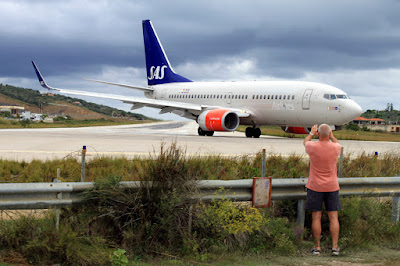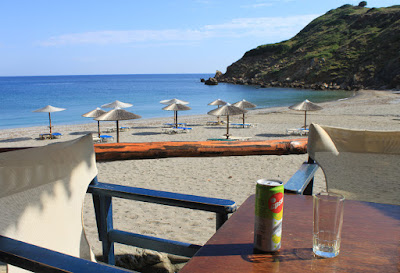The weather is not too good for birding or ringing for a day or two so for today’s blog post there’s a tale from recent Skiathos. "Click the pics" for a clearer view of Greece.
Our first week in Skiathos saw glorious weather, constant temperatures between 28 and 30⁰ and endless clear blue skies. The photograph below shows part of Skiathos and in the right-hand background the neighbouring and larger island of Skopelos as viewed from the Kanapitsa peninsula of Skiathos.
View from Kanapitsa, Skiathos
The scorching weather broke on 22nd and 23rd September with thunderstorms of historic proportions. The Greek mainland and the island of Skopelos bore the brunt of the storms with at times wind and rain reaching tornado strength. In Skopelos the torrential rain created flash floods which poured through the narrow streets and alleys into the harbour below the town. Reports at the time suggested that 10.5 inches of rain fell in the first 24 hours and that 70 or 80 vehicles had been washed into the harbour. Many businesses were destroyed by the ferocity of storm. Thankfully we heard that there was no loss of life and that both islanders and tourists managed to stay safe.
Skopelos
While all this was going on we spent a day and more in our hotel in Agia Paraskevi listening to the thunder, watching the lightening and hearing the rain beat on our patio roof. When we once ventured out during what seemed a lull we found ourselves stuck for an hour or more in a stationary line of traffic at Kolios when a tree crashed across the road ahead of us and brought down power lines.
The mornings after the storm saw huge numbers of birds on the move, displaced by the bad weather systems which stretched across many hundreds of miles. Sitting with my pre-breakfast cup of tea I watched thousands of Barn Swallows, Red-rumped Swallows, House Martins, Common Swifts, Pallid Swifts and Alpine Swifts circling in the grey clouds above. Two parties of Bee Eaters flew over as did a group of 8 Hobbies, several Lesser Kestrels, a couple of Eleonora’s Falcon, at least 3 Marsh Harriers and a number of Ravens. The grey skies allowed time to test the theory that the Hobby has a silhouette like a large swift - it does. Eleonora’s Falcon has a call remarkably similar to Ring-necked Parakeet, a fact which I remembered when searching the sky for a green parrot with a long tail but instead seeing a medium sized falcon!
Hobby
On the third day Sue took the bus to the delights of shopping in Skiathos Town. I made off in the Jimny for Aselinos where the cool of the morning meant that no one wanted to sunbathe. Pools newly created by the recent storms held many Yellow Wagtails as well as Whinchats, Wheatears, Willow Warblers, Chiffchaffs and the ever present shrikes.
Aselinos Beach
Aselinos
Whinchat
Red-backed Shrike
Yellow Wagtail
Yellow Wagtail
Yellow Wagtail
Yellow Wagtail
Wheatear
Yellow Wagtail
Yellow Wagtail
I found a couple of Richard’s Pipits too, a species which according to various sources, may or may not be scarce in Greece but is one that I’ve seen in the same place two years running. There are no Magpies or Jackdaws on Skiathos where apart from the scarce Raven, the representative of the crow family is the ubiquitous Hooded Crow.
Richard's Pipit
Hooded Crow
The Road From Aselinos
As that old proverb goes - “It’s an ill wind that blows no good.” That certainly applies in Skiathos where the normally quiet bird watching of September becomes rather different when bad weather drops migrant birds onto the island.
I just looked at the latest forecast and it looks like there will be a ringing or birding day soon. Log in then for more news, views and photos.
Linking today to Anni's Birding Blog and Stewart's World Bird Wednesday.
Linking today to Anni's Birding Blog and Stewart's World Bird Wednesday.




























































.jpg)











.jpg)












